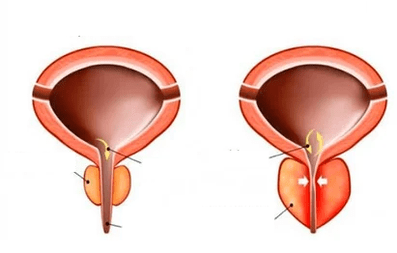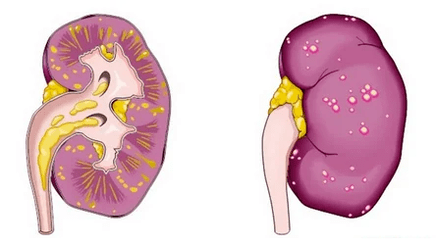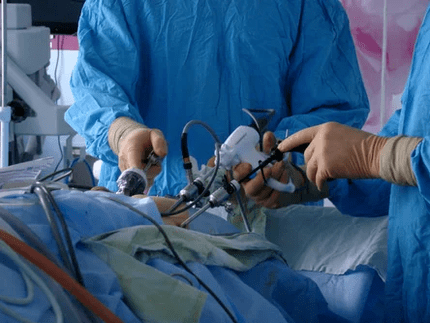
Many doctors jokingly call the male menopause of prostatitis.This disease is diagnosed in 20% of cases in men after forty years, in 70% - after sixty years and 90% of cases after seventy years.The disease can occur in two forms: acute and chronic prostatitis.This disease must be treated, above all because it lends itself well to therapy.But many men ignore unpleasant symptoms, which leads to the development of many complications that become more difficult to cure.
The reasons for development
Acute prostatitis is a pathology of the acute prostate, which develops following the infectious inflammatory process in the organ due to the penetration of pathogens in its tissue.The disease is characterized by the appearance of the swelling of the gland, purulent content in its tissues.This leads to the appearance of many unpleasant symptoms, compromised features of the parental -shared system.
There are many causes of acute prostatitis.In most cases, he provokedPathrotage microbes.Some of the microbes can exist in the body of a healthy person in passive form on the skin or intestine.Under the influence of some factors, they are activated, penetrate the gland tissues and multiply there.Often the disorder appears due to sexually transmitted diseases, for example,Chlamydia, ureaplasmosis, gonorrheaetc.
The acute form of prostatitis also occurs as a complicationurethritis.The microbes fall through the ducts that open in the urethra.Furthermore, often the cause of prostatitis is the spread of bacteria from other organs of the parental parent system.Often iron can be influencedDuring surgical manipulations, catheterization, diagnostic measures.
Since there is a large amount of blood vessels in the prostate gland, the infection here can obtain a blood flow in the presence of chronic pathologies in the body, for exampleTonsillitis, bronchitis etc.If they are not thereAnal cracksPerhaps the penetration of microbes in a prostate with a lymphatic current.
But infections do not always lead to the development of the disease.Stagnant phenomena in the vases of the pelvic region that developwith prolonged abstinence from sexual contacts or a huge number.
Stagnant phenomena are associatedLack of physical activity, constant constipation, alcoholism, varicose veins in the pelvic region, hypothermia of the body.
Classification
In urology different forms of pathology are distinguished, which are its development phases:
- Catarrhal formIt is characterized by the appearance of inflammation in the organ, a change in its mucous epithelium.Over time, swelling of the gland occurs, a mucous secret is gathered in it, contributing to the progression of the disease.
- So focal suppuration appears.The disease goes to the second stage (form) -Folial form.Stretted or clogging urinary conduits, the secret ceases to stand out normally from the body.Pus can be released into the urinary channel, forming purulent outbreaks there.The cells of the glands change, the prostate continues to swell and increase in size.
- Parenchymal formIt develops when the organ is completely inflamed, it develops purulent infection.In the absence of therapy, small purulent fires merge into a huge one, an abscess develops, which often opens in the urethra, intestine and bladder.In some cases, it is possible to immediately develop this form of pathology when the infection penetrates into the interstitial tissue of the organ with a flow of blood or lymphatic.

Symptoms
The symptoms are vividly pronounced prostatitis.How visible and evident the signs will depend on the form (stage) of the disease.The general signs of the disease include the following:
- pain syndrome during the elimination of urine;
- symptoms of intoxication;
- pain in the genital region;
- Frequently entitled to the bathroom, especially at night;
- The discharges from the urethra are possible.
As prostatitis advances in a man, pain syndrome will spread to other areas.This is due to the transmission of impulses from nerve finals.Urine excretion becomes very painful.Often in this phase, its strong delay develops, which is considered a dangerous state, as it can lead to the breakdown of the bladder.
Symptoms in acute prostatitis continue to increase.A strong pain in defecation appears, body temperature increases.The prostate becomes increased, dense and painful.Urina will be muddy due to the content of pus and mucus.
At the last phase, the disease manifests itself strongly.
Body temperature increases considerably, fever and chills, loss of appetite, strong weakness, exhaustion of the body as a whole.The urination can stop completely, when trying to go to the bathroom, a man will feel severe acute pain.This condition is painful, pain syndrome begins to spread throughout the pelvic area.A man cannot find a place for himself, he is forced to lie with compressed limbs.If inflammation spreads to the rectum, the mucus will come out of the anus.A yellow-green mucus with a mixture of blood is released from the urinary channel.

This condition can causeSepsis, cystitis, pylonfritis, chronic prostatitis, abscess.In this case, the patient's urgent hospitalization and emergency treatment is required.
Diagnostics
Since the symptoms of acute prostatitis in men appear quite brilliantly, the doctor can immediately suspect the pathology.But he needs to conduct an in -depth examination.The rectal exam in this case is strictly contraindicated.
The urologist must determine the stadium (form) of the disease using laboratory and instrumental techniques.The doctor takesThe secret of the prostatefor research.The concentration of leukocytes will increase, which indicates acute inflammation.
Then performBlood and urine laboratory tests.The urine is sent for bacteriological sowing for the study, as well as the determination of the pathogen of the infection and its sensitivity to antibacterial drugs.It is also possible:
- PCR to determine the STD;
- Uroflooma to identify the gravity of violations in the organ;
- An ultrasound of the prostate to determine the shape and size of the organ, changes in it, the phases of the course of the disease;
- The dopplerometry helps to distinguish acute prostatitis from other pathologies;
- The magnetic resonance of the pelvic organs is often prescribed when planning surgery;
- Analysis of the concentration of spa in the blood;
- study of the resignation blows from the urethra;
- Punting of the sections of the body with suspicion of purulent infection and abscess.
Treatment
How to treat acute prostatitis, a urologist will say it in detail.The main component of the therapy is the antibacterial drug, which is selected in accordance with Bakposev's results.For two or three days, the antibiotic begins to help, a person feels much better, the pain begins to subside.But with this form of disease, these drugs must be taken for a month, even if the symptoms have completely disappeared.
This is also necessary so that the disease does not turn into a chronic form, which is observed quite often.
When choosing the drug, the doctor takes into account other factors:
- Some products penetrate badly into the gland fabric;
- Other funds are accumulated in fabrics in large quantities.
The treatment of acute prostatitis in men should be based on the use of powerful drugs, as in other cases that threaten human life.Generally, doctors are prescribed fluorochinoloni.When using macrolides, the dosage should be great.This is particularly true in patients with immunosuppression.
Generally, antibiotics are administered using intravenous injections.In the initial phase, the disease can be treated at home or outpatient.In this case, bed rest is prescribed, since any power load can cause the spread of the infection and the development of the sepsis.
In combination with antibiotics, the following drugs are also prescribed:
- analgesics;
- antipyretic drugs;
- Fanss;
- With severe pain, an opiate can be prescribed;
- diuretics to reduce body intoxication;
- laxatives in order to facilitate defecation;
- antispasmodic drugs to facilitate the excretion of the urine;
- Alpha Blocker.
If a man has a strong delay in the urine, he urea catheter is performed.Antiandrogens are often used to reduce swelling and inflammation in the organ, improve the outflow of secretion, normalize the blood flow in the gland and reduce the risk of infection in the body.
Hormones can be used, for example estrogen, cold enemas for the removal of edema and pain.The massage and thermal procedures in this form of the disease are severely prohibited.They can only be used during the recovery period.
Surgery

In the absence of pain, the doctor can suspect the development of the ascess.In this case, surgery is carried out to eliminate the areas on which it occurs.Often use the pointing drainage of the abscess.In serious and extreme cases, the organ is removed.
The operation is prescribed in the presence of an abscess, a sharp delay of the urine, a strong pain syndrome, which is not eliminated by any drug, the appearance of stones and neoplasms, as well as with the ineffectiveness of the pharmacological treatment, frequent infections of the parental system, paraprococtitis.
The surgeon can use one of the following methods:
- Corpse (transurereral resection)Implies the removal of the interior of the organ.Used more often;
- ProstatectomyIt involves a partial or complete removal of the organ through an incision in the lower abdomen;
- Laser operation.In this case, the affected areas of the body are removed using a laser;
- Downs of the abscessIt is carried out through the rectum.The drainage is introduced in the engraving through which the PUS is pumped;
- To facilitate urine excretion, it is performedTransureal engravingin the organ.
When the structure of the gland fabric is restored, its functions are normalized, the secret of the prostate normalizes its composition, the pathogen will be completely eliminated by the body, we can speak of the treatment of prostatitis.
Forecast
During therapy, the prognosis of the disease will be good.Sometimes the negative consequences of acute prostatitis develop.The disease can go to a chronic form, so it will be more difficult to eliminate.The dangerous consequences of an untreated disease are the abscess of the organ, the sepsis and acute urinary retention.In some cases, due to the appearance of complications, death may occur.But usually men do not allow these consequences for the development of these consequences, when they come from the doctor and begin the course of therapy.
Prevention

In order to prevent prevention, it is necessary to prevent the appearance of predisposing factors.This promptly requires the treatment of all infections in the body so that they do not turn into a chronic form and do not become potential outbreaks of infection, which will spread to the prostate gland.
When surgical manipulations lead, the doctor should pay attention to the use of antiseptics.Otherwise, the risk of microbes enters the patient's body.It is important that man and his sexual partner are promptly dealing with the MST, and it is better to prevent their appearance.Sex life should take place with a permanent partner, it should be regular.
It is necessary to guide a mobile lifestyle, practice sports or perform physical exercises, observe the rules of intimate hygiene.
Men usually turn to doctors in extreme cases.But when negative signs appear, it is better to contact them immediately.This will help to avoid many health problems and also in some cases to save life.













